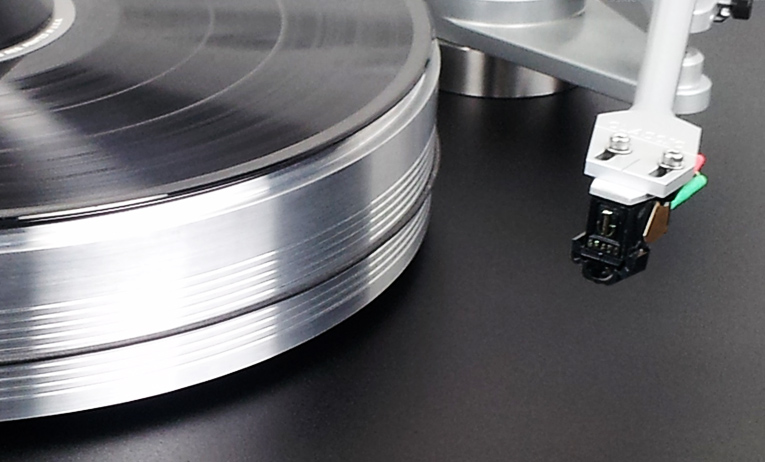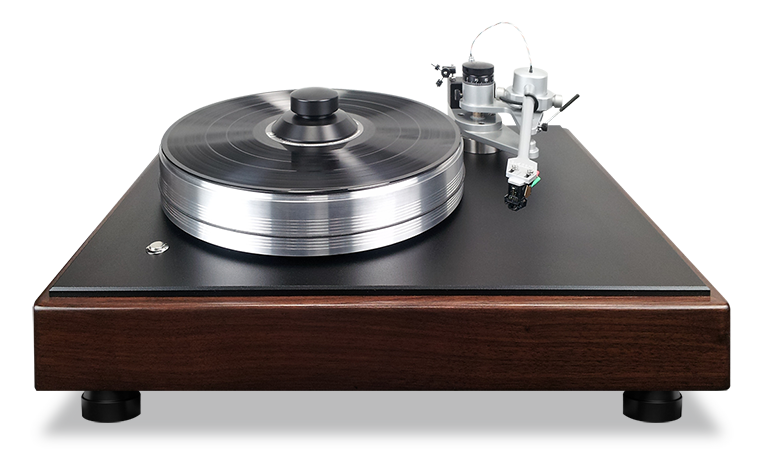 These days, it seems there are as many different approaches to turntable design as there are turntables. At one end of the spectrum is the low-mass, quick-dissipation approach; at the other, the massive, vibration-damping method. One look is all it takes to tell you that VPI Industries’ Classic 2 turntable is firmly at the massive end. It’s also clear that the Classic 2 harks back to the golden age of analog replay, using time-tested materials in a retro package that looks more 1964 than 2014. To say that the Classic 2 is a throwback would be an understatement: It looks, in the best sense of the phrase, about as old-school as a modern turntable can get.
These days, it seems there are as many different approaches to turntable design as there are turntables. At one end of the spectrum is the low-mass, quick-dissipation approach; at the other, the massive, vibration-damping method. One look is all it takes to tell you that VPI Industries’ Classic 2 turntable is firmly at the massive end. It’s also clear that the Classic 2 harks back to the golden age of analog replay, using time-tested materials in a retro package that looks more 1964 than 2014. To say that the Classic 2 is a throwback would be an understatement: It looks, in the best sense of the phrase, about as old-school as a modern turntable can get.
Despite this turntable’s retro looks, it’s evident that VPI has taken advantage of the latest in manufacturing technology to produce the Classic 2 ($4000 USD). Its core consists of a solid, 2.5"-thick block of laminated MDF silicone-bonded to a top plate of 11-gauge steel. The chassis is held together with long, sturdy bolts that penetrate all layers to help reduce any random motion or unwanted vibration. Four adjustable, chunky Delrin feet support the works. The review sample had thick slabs of real walnut wood on all four sides; black oak is also available.
A massive, inverted bearing with a stainless-steel shaft is bolted to the plinth, and mates with the well of an 18-pound platter machined from a solid billet of aircraft-grade 6061 -- an alloy of aluminum, magnesium, and silicon. The platter is belt-driven by a heavy-duty, AC-synchronous, 600rpm motor rigidly mounted to the plinth. The platter’s spindle is threaded to accept the supplied record clamp. The speed (33 or 45rpm) is changed by moving the belt onto the appropriate portion of the motor’s stepped Delrin pulley. A rubberized record mat is also included.
Bolted to the Classic 2’s chassis is the 10.5” Classic 2 tonearm, also made from 6061 aluminum. Its tapered armtube has a unipivot bearing and a dropped counterweight to lower its center of gravity; if necessary, it can be rotated to fine-tune the azimuth. The arm’s base includes a calibrated micro-adjustment dial that cleverly moves the entire arm assembly up or down, for on-the-fly adjustment of vertical tracking angle (VTA). (For those who don’t require this, the Classic 1 is available, for $1000 less.) Signal wiring terminates in VPI’s standard Lemo connector and RCA junction box pairing.
Setting up the Classic 2s was relatively fuss free, thanks in no small part to the most comprehensive assortment of turntable-setup tools I’ve ever seen: VPI’s own cartridge-alignment gauge; a digital tracking-force scale; a thin headshell rod for azimuth adjustment; viscous damping fluid for the tonearm pivot; and, in case you’re new to vinyl, even a copy of the DVD 21st Century Vinyl: Michael Fremer’s Practical Guide to Turntable Set-Up.
The Classic 2’s instruction manual is detailed enough for a beginner to have it set up in about 20 minutes -- quicker if VPI or the dealer has pre-installed the cartridge. I installed my own Lyra Delos using VPI’s protractor, which uses an alignment scheme based on the Dennesen gauge of yore. The only section of the manual I found a little unclear for beginners concerns the mechanical antiskate attachment: The information given basically says that VPI prefers to go without antiskate, so you can use it or not. A picture shows you where the device goes, but it’s up to you to figure out its proper orientation and the required amount of force. I settled on the correct string positioning on the antiskate rod by eyeballing the stylus for minimal lateral motion during record play.

After setting the tracking force, it was time to see what effect damping the tonearm would have on the sound -- VPI recommends this for Clearaudio or Grado cartridges. I didn’t have a pickup from either of those brands, so I can’t attest to the damping fluid’s effectiveness for them. I can tell you, however, that even with the pivot only half full of fluid, also per VPI’s recommendation, my Lyra Delos sounded slow, clumsy, and lethargic; I quickly cleaned out the fluid and left the arm undamped.
Also, a note about the Classic 2’s on-the-fly VTA adjustment: It’s a killer feature, but ultimately wasn’t for me, mostly because I’m too used to listening without messing with VTA. It certainly made a difference in the sound, but I’m a set-it-and-forget-it sort of vinyl junkie and didn’t really need the feature. If you’re fond of endlessly tweaking VTA and want to do so on the fly, the Classic 2’s mechanism is one of the best ways I’ve seen that accomplishes this without compromising structural rigidity or performance. Otherwise, save yourself a cool grand and go with the Classic 1.
With that done, all that was left was to settle in with some good tunes. I began my evaluation with some Miles Davis that was literally and figuratively classic: Classic Records’ 200gm reissue of Kind of Blue (Columbia/Classic CS 8163). The VPI Classic 2 quickly impressed with its . . . nothingness: the ’table was phenomenally quiet, with almost dead silence at the lead-in groove. Once the music started, though, it enveloped and expanded into the room in a way only a high-mass ’table can: The Classic 2 put forth a positively huge sound that was rich, warm, and fulsome in the lows, with an easygoing, relaxed character and rock-solid stability.
For example, Paul Chambers’s double bass in the opening bars of “So What” sounded pleasantly plump and full of woody character while still remaining firm; his solo in “Freddie Freeloader” was taut, weighty, and extended throughout. Bill Evans’s piano was quietly powerful, his left hand playing with a delicate yet purposeful force. This sort of steady, anchored sound is the hallmark of mass-loaded turntables, and in this regard the VPI didn’t disappoint. It also had me reaching for albums that benefited from its brand of iron-fisted grip, such as Airhead’s For Years (R&S RS1308LP). The VPI exerted unflappable control over this album’s generous, subterranean synth bass while allowing it to fully bloom into the room.
Concentrating on the midrange highlighted the Classic 2’s easygoing nature. Guitar and female voices, in particular, could sound seductively warm and somewhat lush through the VPI. Nowhere was this more evident than with an excellent album of acoustic jazz, the Susie Arioli Band’s That’s for Me (Justin Time 195). The VPI delivered all of Arioli’s breathy yet unaffected timbre and then some, imbuing her voice with a hint of the honeyed, golden midrange glow that tube lovers rave about. Jordan Officer’s guitar, strummed with nice plumminess and texture, allowed me to sink deeply into the music.
This midrange glow was also evident with male voices, such as Frank Sinatra’s in his A Swingin’ Affair! (Capitol CAPS26-0017-1). In this 1957 album, Sinatra channels some of his youthful crooner energy into his more mature swagger, and the VPI Classic 2 delivered it all in spades, putting just enough roundness around the edges of Sinatra’s voice to make for comforting, relaxing listening. Nelson Riddle’s polished orchestral arrangements also seemed a bit rounded, with a tonality that was slightly dark, mildly recessed, but oh, so lush.
About the only area where I would have preferred a smidge more was the treble. The Classic 2 didn’t sound dull by any means, but it did have a shade less brilliance and bite in the upper registers than I’m used to hearing. In “But Now I’m Back” and “Sunday Table,” from Pink Martini’s Splendor in the Grass (Heinz HNZ006LP), cymbals, horns, and high-pitched strings seemed a touch more muted than they should’ve been. These instruments did, however, have a nice, tangible presence, sounding chunky and substantial when called for.
The Pink Martini record also showcased the Classic 2’s imaging capabilities. This album’s layered big-band and orchestral arrangements spread into the room with excellent width and depth, making a fine backdrop for singer China Forbes’s larger-than-life performances. Whether this was due to the sense of scale it projected, its unwavering foundational stability, or some combination of those qualities, the VPI did a good job of wrapping the recorded acoustic around me. But while its sound was highly enveloping, it was never artificially overblown or distracting. To hear how well the Classic 2 immersed me in the performance, play a good symphonic recording, such as Fritz Reiner and the Chicago Symphony’s of Rimsky-Korsakov’s Scheherazade (RCA Living Stereo/Classic LSC-2446). It was adept at communicating the feel and acoustic space of Chicago’s Orchestra Hall, even if there were shades less detail and precision than are revealed by some other, similarly priced turntables.

Speaking of other ’tables, how did the Classic 2 stack up? I compared it with my reference vinyl spinner, Rega Research’s outstanding RP8. Priced comparably with the Classic 2 -- or precisely the same as Classic 1 -- at a whisker under $3000, the RP8 offers class-leading sound, high build quality, and tremendous value for the money, easily earning a Reviewers’ Choice award. With its low-mass design, skeletal plinth, and thoroughly modern looks, the RP8 is quite a visual contrast to the massive VPI.
Its sound, too, is a contrast. With Kind of Blue, the Classic 2 emphasized the mid- and upper bass for a weightier sound, but the RP8 made Paul Chambers’s bass sound quicker, nimbler, more articulate. In terms of detail, the Rega made it easier to hear individual notes within the chords as Bill Evans comped along with the tune; the RP8 also delivered the initial attack component of felt hammers hitting strings with more precision and definition. However, the VPI countered by producing more of the piano’s resonant body sound, and James Cobb’s cymbals had more solidity and presence, even as the Rega brought out more of their delicate shimmer and decay.
The Classic 2’s laid-back sound proved a welcome antidote for thin- or hot-sounding recordings, such as the Shins’ debut, Oh, Inverted World (Sub Pop SP 70550). While the RP8 delivered this album’s sound with greater honesty, the Classic 2 put some much-needed fullness back into James Mercer’s voice, and added some bass weight to boot.
When it came to dynamics, the RP8 had the upper hand. With the Shins’ third album, Wincing the Night Away, the Rega better tracked crescendos and other dynamic changes, sounding altogether more thrillingly explosive. It also better communicated microdynamic details, such as the tambourine accents peppered throughout “Sleeping Lessons,” and the distant, spoken interlude between that and the next track, “Australia.” The Classic 2 had the upper hand when it came to macrodynamic reach, but the Rega RP8 was simply more dynamically expressive.
Rhythmically, the Classic 2 kept a rock-solid beat, with steady tempo and excellent pitch stability. But even with all that steadiness, it couldn’t quite match the Rega’s quick, fleet-footed articulation of rhythms. For example, “Before Your Very Eyes,” from Atoms for Peace’s Amok (XL Recordings XLLP 583), had better pacing and more propulsive momentum via the Rega; so, too, did “The Way You Look Tonight,” from Susie Arioli’s That’s for Me. The Classic 2 was no slouch at rhythm and timing, but the RP8 pushed the music forward in a way that was more incisive, exciting, and energetic overall.
Both turntables make for compelling music listening. The VPI made it easy for me to kick my heels up, take a load off, and relax into the sound; the Rega encouraged me to lean in and pay attention to the music being made in front of me. Which you’ll like better will likely depend on your listening preferences and system compatibility.
Conclusion
With a mildly retro sound to partner its totally retro looks, the VPI Classic 2 proved to be a high-performing, no-nonsense, musically capable turntable: Its warm, fulsome sound should be an outstanding match for those listeners wanting a relaxed, easygoing turntable they can comfortably sink their ears into. Its simple setup, versatile configuration and playback options, and imperviousness to noise make the Classic 2 a no-brainer recommendation for experienced and beginner vinyl spinners alike. It’s amazing that such a beautifully built, high-quality turntable can be made right here in the US for a fairly reasonable sum. If you’re looking for a turntable and tonearm for about $4000 and feel the sound of your system is tilted a bit toward the lean, the hard, and the etched, I can’t think of a more perfect antidote than the VPI Classic 2.
. . . Oliver Amnuayphol
olivera@soundstagenetwork.com
Associated Equipment
- Loudspeakers -- Aperion Audio Verus Grand Tower, Axiom M100, KEF R700
- Integrated amplifiers -- Marantz PM-KI Pearl, Pathos Logos Mk.II
- Phono preamplifiers -- Graham Slee Revelation M, Pro-Ject Phono Box RS
- Step-up transformer -- Custom-made Sowter Magnetics 9570 (1:10)
- Source -- Rega Research RP8 turntable, Lyra Delos cartridge
- Analog interconnects -- Custom single-core, copper RCA cables; Blue Jeans Cable LC-1
- Power cords -- WireWorld Aurora 5.2 and Electra 5.2
- Speaker cables -- WireWorld Oasis 6
VPI Industries Classic 2 Turntable and Classic 2 Tonearm
Price: $4000 USD.
Warranty: Three years parts and labor.
VPI Industries Inc.
77 Cliffwood Ave. #3B
Cliffwood, NJ 07721-1087
E-mail: sales@vpiindustries.com
Website: www.vpiindustries.com






















